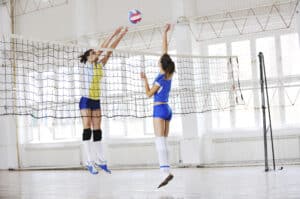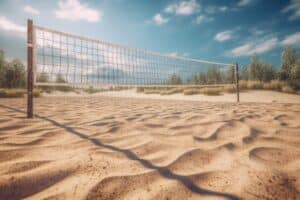How do beach volleyball players not burn their feet?
Key Takeaways
- Specialized footwear, such as sandals and socks, provide a barrier between the feet and the hot sand, preventing direct contact and reducing the risk of burns.
- The materials used in specialized footwear, like rubber or neoprene for sandals and polyester or nylon for socks, are carefully chosen to provide protection and comfort.
- Applying sunscreen to the feet helps to protect them from the harmful effects of the sun’s rays, reducing the risk of sunburn and skin damage.
Beach volleyball is a popular sport enjoyed by many around the world. It is played on sandy beaches, where players have to constantly move and jump to make plays. One might wonder, with the scorching hot sand, how do beach volleyball players manage to protect their feet from getting burned? In this article, we will explore the various methods employed by these athletes to ensure their feet stay safe and comfortable during intense matches.
Specialized Footwear
One of the most common ways beach volleyball players prevent their feet from burning is by wearing specialized footwear. These footwear options are designed to provide a barrier between the hot sand and the players’ feet, allowing them to move freely without the risk of burns. Sandals and socks are two popular choices among beach volleyball players.
Sandals offer a breathable and lightweight option for players. They provide protection to the sole of the foot while allowing air circulation to keep the feet cool. The open design of sandals also helps to prevent the buildup of sand, ensuring that players can move without any discomfort.
Socks, on the other hand, provide a different type of protection. They act as a barrier between the foot and the hot sand, preventing direct contact and reducing the risk of burns. Some beach volleyball players prefer wearing thin socks made of moisture-wicking materials to keep their feet cool and dry.
Footwear Materials
The materials used in the construction of specialized beach volleyball footwear also play a crucial role in preventing burns. These materials are carefully chosen to provide a balance between protection and comfort.
Many sandals designed for beach volleyball are made from heat-resistant materials such as rubber or neoprene. These materials are able to withstand high temperatures without transferring excessive heat to the feet. Additionally, they often have textured soles that provide traction on the sand, allowing players to move with agility and stability.
For socks, lightweight and breathable materials like polyester or nylon are commonly used. These materials help to wick away moisture and keep the feet cool, even in hot conditions. Some socks also incorporate special features like reinforced soles or extra padding to provide additional comfort and protection.
Applying Sunscreen
In addition to specialized footwear, beach volleyball players often apply sunscreen to their feet to protect them from the harmful effects of the sun’s rays. Sunscreen helps to prevent sunburn and reduces the risk of skin damage caused by prolonged exposure to UV radiation. It is important for players to choose a sunscreen with a high SPF and to reapply it regularly throughout the game.
Playing Techniques
Experienced beach volleyball players also employ certain techniques to minimize the risk of burning their feet. One such technique is constantly moving and shifting their weight during breaks in play. By avoiding prolonged contact with the sand in one spot, players can prevent excessive heat buildup in a specific area.
Furthermore, players may choose to play in shaded areas whenever possible. This helps to reduce the overall temperature of the sand and lowers the risk of burns. Seeking shade during breaks or using umbrellas can provide much-needed relief from the heat.
Conclusion
Beach volleyball players have adopted various strategies to protect their feet from burning on hot sand. Specialized footwear, such as sandals and socks, offer a barrier between the feet and the sand, preventing direct contact and reducing the risk of burns. The materials used in these footwear options are carefully chosen to provide comfort and protection. In addition to footwear, applying sunscreen and employing specific playing techniques can further enhance foot protection. By using these methods, beach volleyball players can focus on the game without worrying about the scorching heat of the sand.
Related Websites:
FAQs:
Q: Why is beach volleyball so popular?
Beach volleyball is popular because it combines the fun of playing a sport with the enjoyment of being at the beach. It’s a great way to stay active, socialize, and enjoy the beautiful scenery.
Q: How can I prevent burning feet while playing beach volleyball?
To prevent burning feet while playing beach volleyball, you can try wearing specialized footwear designed for the sport. These shoes provide protection and ventilation. Additionally, you can apply sunscreen to your feet and choose a high SPF to protect them from the sun’s heat.
Q: What are the different types of footwear options for beach volleyball?
There are various footwear options for beach volleyball, including sandals, water shoes, and beach volleyball specific shoes. Sandals provide breathability but may offer less support, while water shoes offer protection and traction. Beach volleyball shoes are designed with specialized features for optimal performance and comfort.
Q: How can I reduce the heat on the sand?
To reduce the heat on the sand, you can choose to play during cooler hours, such as early morning or late afternoon. Wetting the sand before playing can also help cool it down. Additionally, using towels or mats to create a barrier between your feet and the sand can provide some relief.
Q: What are some tips from professional beach volleyball players to protect feet?
Professional beach volleyball players recommend proper foot care and maintenance to prevent burning feet. They also emphasize the importance of applying sunscreen with a high SPF and utilizing shade or time management during play to minimize exposure to the sun’s heat.






